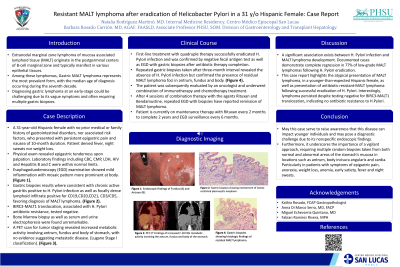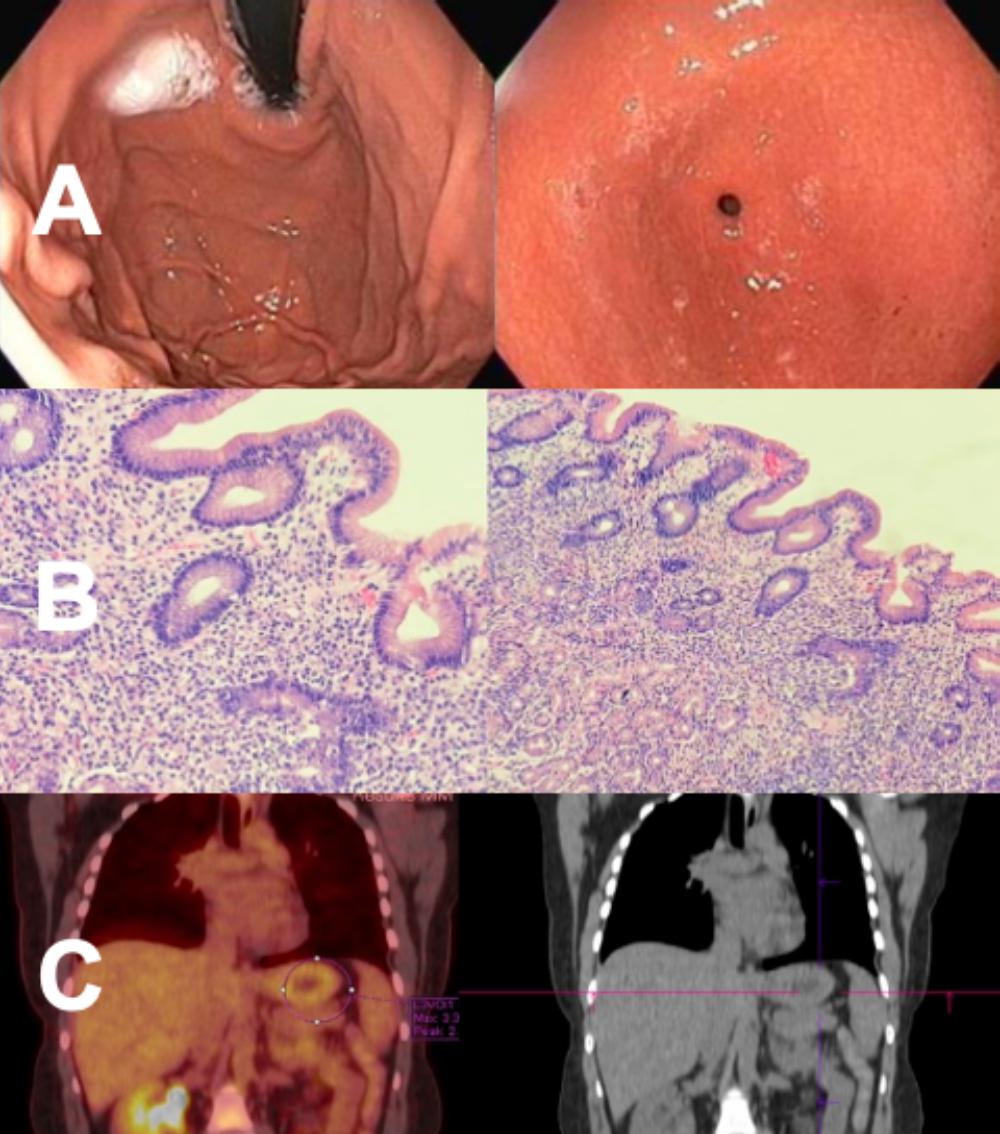Sunday Poster Session
Category: Stomach
P1695 - Resistant MALT Lymphoma After Eradication of Helicobacter Pylori in a 31-year-old Hispanic Female: A Case Report
Sunday, October 27, 2024
3:30 PM - 7:00 PM ET
Location: Exhibit Hall E

Has Audio

Natalia Rodriguez-Martino, MD
Saint Luke's Hospital
San Juan, PR
Presenting Author(s)
Natalia Rodriguez-Martino, MD1, Barbara Rosado-Carrion, MD2
1Saint Luke's Hospital, San Juan, Puerto Rico; 2Ponce Health Sciences University, San Juan, Puerto Rico
Introduction: Extranodal marginal zone lymphoma of mucosa-associated lymphoid tissue (MALT) originate in the post-germinal centers of B-cell marginal zone and typically manifest in various epithelial tissues. Among these lymphomas, Gastric MALT represents the most prevalent form, with the median age of diagnosis occurring in the seventh decade of life. Diagnosing gastric lymphoma at an early stage could be challenging due to its vague symptoms and often requires multiple gastric biopsies.
Case Description/Methods: A 31-year-old Hispanic female with no prior medical or family history of gastrointestinal disorders presented with persistent epigastric pain and nausea of 10 months. She denied fever, night sweats or weight loss. Physical exam revealed epigastric tenderness and laboratory findings were normal. Esophagoduodenoscopy (EGD) examination showed mild inflammation with a mosaic pattern. Gastric biopsies revealed chronic active gastritis positive to H. Pylori and focally dense lymphoid infiltrate positive for CD19, CD20 and CD3/CD5, consistent with MALT lymphoma. BIRC3-MALT1 translocation, associated with H. Pylori antibiotic resistance, was negative. Bone marrow biopsy and serum and urine electrophoresis were unremarkable. A PET scan showed increased metabolic activity involving antrum, fundus and body of stomach, without evidence suggesting metastatic disease. First-line treatment with quadruple therapy successfully eradicated H. Pylori, confirmed by negative fecal antigen test and EGD with gastric biopsies post-treatment. However, repeat biopsies after three-months revealed residual MALT lymphoma foci. The patient then received combination of immunotherapy and chemotherapy. After four sessions of Rituxan and Bendamustine, EGD with biopsies reported remission of MALT. She is now on maintenance therapy with Rituxan every two months for two years and undergoes EGD surveillance every six months.
Discussion: This case report highlights the atypical presentation of MALT lymphoma in a younger-than-expected Hispanic female and the persistence of lymphoma following successful eradication of H. Pylori, despite testing negative for BIRC3-MALT1 translocation. This case underscores that MALT lymphoma can affect younger individuals and presents diagnostic challenges due to nonspecific endoscopic findings. It emphasizes the importance of a vigilant approach, requiring multiple random biopsies from both normal and abnormal stomach mucosa, especially in patients presenting with symptoms.

Disclosures:
Natalia Rodriguez-Martino, MD1, Barbara Rosado-Carrion, MD2. P1695 - Resistant MALT Lymphoma After Eradication of <i>Helicobacter Pylori</i> in a 31-year-old Hispanic Female: A Case Report, ACG 2024 Annual Scientific Meeting Abstracts. Philadelphia, PA: American College of Gastroenterology.
1Saint Luke's Hospital, San Juan, Puerto Rico; 2Ponce Health Sciences University, San Juan, Puerto Rico
Introduction: Extranodal marginal zone lymphoma of mucosa-associated lymphoid tissue (MALT) originate in the post-germinal centers of B-cell marginal zone and typically manifest in various epithelial tissues. Among these lymphomas, Gastric MALT represents the most prevalent form, with the median age of diagnosis occurring in the seventh decade of life. Diagnosing gastric lymphoma at an early stage could be challenging due to its vague symptoms and often requires multiple gastric biopsies.
Case Description/Methods: A 31-year-old Hispanic female with no prior medical or family history of gastrointestinal disorders presented with persistent epigastric pain and nausea of 10 months. She denied fever, night sweats or weight loss. Physical exam revealed epigastric tenderness and laboratory findings were normal. Esophagoduodenoscopy (EGD) examination showed mild inflammation with a mosaic pattern. Gastric biopsies revealed chronic active gastritis positive to H. Pylori and focally dense lymphoid infiltrate positive for CD19, CD20 and CD3/CD5, consistent with MALT lymphoma. BIRC3-MALT1 translocation, associated with H. Pylori antibiotic resistance, was negative. Bone marrow biopsy and serum and urine electrophoresis were unremarkable. A PET scan showed increased metabolic activity involving antrum, fundus and body of stomach, without evidence suggesting metastatic disease. First-line treatment with quadruple therapy successfully eradicated H. Pylori, confirmed by negative fecal antigen test and EGD with gastric biopsies post-treatment. However, repeat biopsies after three-months revealed residual MALT lymphoma foci. The patient then received combination of immunotherapy and chemotherapy. After four sessions of Rituxan and Bendamustine, EGD with biopsies reported remission of MALT. She is now on maintenance therapy with Rituxan every two months for two years and undergoes EGD surveillance every six months.
Discussion: This case report highlights the atypical presentation of MALT lymphoma in a younger-than-expected Hispanic female and the persistence of lymphoma following successful eradication of H. Pylori, despite testing negative for BIRC3-MALT1 translocation. This case underscores that MALT lymphoma can affect younger individuals and presents diagnostic challenges due to nonspecific endoscopic findings. It emphasizes the importance of a vigilant approach, requiring multiple random biopsies from both normal and abnormal stomach mucosa, especially in patients presenting with symptoms.

Figure: A. Endoscopic findings of fundus and antrum.
B. Gastric biopsies showing involvement of lambda restricted plasmacytic neoplasm.
C. PET findings showing increased metabolic activity in antrum, fundus and body of the stomach.
B. Gastric biopsies showing involvement of lambda restricted plasmacytic neoplasm.
C. PET findings showing increased metabolic activity in antrum, fundus and body of the stomach.
Disclosures:
Natalia Rodriguez-Martino indicated no relevant financial relationships.
Barbara Rosado-Carrion indicated no relevant financial relationships.
Natalia Rodriguez-Martino, MD1, Barbara Rosado-Carrion, MD2. P1695 - Resistant MALT Lymphoma After Eradication of <i>Helicobacter Pylori</i> in a 31-year-old Hispanic Female: A Case Report, ACG 2024 Annual Scientific Meeting Abstracts. Philadelphia, PA: American College of Gastroenterology.
